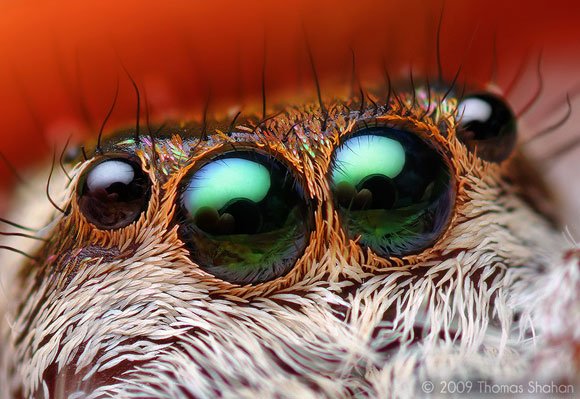
Hello all! In this short piece, we'd like to introduce you to some background info on visual systems, and give you some insights on howjumping spider vision works, and how it compares to our own! As you may have noticed from our various pictures, jumpingspiders, like most arachnids, have eight eyes in total. These are arranged infour pairs, and in fact, each pair of eyes is special! The two big puppy-dogeyes on the front have the highest resolution, and it is only in these eyesthat jumping spiders can see color. The field of view is very limited, but canbe moved around in a small arc. These color-sensitive eyes can only see objectsthat are within 30 degrees from thecenter. Outside of this range, jumping spiders, even all the colorful ones westudy, are color-blind! They can, however, still see all around them, albeitwith different types of eyes. Jumping spiders have 2 pairs of lateral eyes,which are smaller than their principal eyes. These lateral eyes sit on the fourcorners of a jumping spider's boxy head, giving them the ability to seeeverything around them! While these eyes are not color sensitive, and havelower resolution , they arevery motion sensitive. This allows jumping spiders to detect possible objectsof interest no matter where they are! After detecting something interesting,these animals quickly swivel their body around to fix their principal eyes onthe subject and scan it with high quality vision. Lastly, jumping spidershave one pair of small, upwards facing eyes which may have a role innavigation. With all these special eyes working together, jumping spidersmanage to accomplish complicated visual tasks and are very efficient hunters! This complex system of eight eyes may sound foreign whencompared to our single eye pair, but in fact, a lot of the principles at workare the same. Much like how jumping spiders have different eyes specialized forseeing different things, our eyes have special regions within them that seedifferently! Like jumping spiders, we are more sensitive to motion in theperiphery of our field of view. While our brain tells us that we see in colorall around us, most of the color-sensitive ‘cone cells’ of our retinas areactually only located in the fovea, a tiny area in the center. If you stick your arms out in front of you, your fovea only covers the same visual area asyour two thumbnails put side by side. Compared to our entire visual field, thisis quite small, which is why we, like jumping spiders, have to move our eyes toscan scenes. No matter how many eyes contribute, the brain stitches togetherthe information each eye supplies, to form a unified field of view.
spiders suck man lol
not the biggest fan of those guys
Amazing macro! I am afraid of many spiders. Recently my son caught a Carolina Wolf Spider on our sofa.